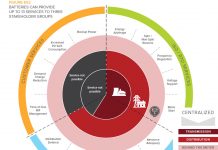John Petersen
In recent years lithium-ion batteries have been portrayed as glamorous, sleek, sexy and hot – the stuff of adolescent fantasy and mid-life crisis. Reality is more like a surreal remake of the Dance of the Hours sequence in the Disney classic Fantasia where hippos in pink tutus gossip about overweight dancing elephants. Let’s face it folks, there are no cheetahs in the battery ballet. While lithium-ion battery packs are smaller and lighter than their lead-acid counterparts, both types of batteries are ridiculously heavy substitutes for a fuel tank. The sad part is that whispers from hippos have convinced dreamers of all ages that energy is more valuable than power and diverted attention from the harsh truth that no current battery technology is cheap enough or light enough to make electric drive competitive with internal combustion.
Reduced to basics energy is a measure of the amount of electricity a battery can store while power is a measure of how quickly the battery can deliver its stored electricity. While energy applications typically cycle a battery once or twice a day, power applications usually cycle a battery dozens of times a day. Once you accept the idea that each charge-discharge cycle has a determinable value, it’s easy to see why the payback from power applications usually exceeds the payback from energy applications by a wide margin.
Hippos in pink tutus want us to believe a new age of electric drive is just around the corner. But at last December’s United Nations Climate Change Conference in Cancun, Secretary of Energy Steven Chu offered an entirely different and uncharacteristically blunt assessment:
“And what would it take to be competitive? It will take a battery, first that can last for 15 years of deep discharges. You need about five as a minimum, but really six- or seven-times higher storage capacity and you need to bring the price down by about a factor of three. And then all of a sudden you have a comparably performing car; let’s say a mid-sized car which has a comparable acceleration and a comparable range.”
In the simplest of terms, electric drive can’t be competitive with internal combustion until somebody invents and commercializes an entirely new class of battery. In the meantime, the market will remain profoundly confused by snake oil suggestions that the cleantech revolution will mirror the progress that information and communications technology made over the last four decades. It’s just not going to happen!
The miracle of the iPad isn’t the result of better batteries. It’s better electronics that do more work, but only use a small fraction of the energy the legacy technologies required. The eco-clerics and hopium pushers in our midst do not like these truths, but they’re truths nonetheless.
In November of 2008 I created list of 13 pure play storage companies and promised to track their performance over time. Since then I’ve added five companies to the list (names in italics) and broken it down into peer groups to facilitate comparisons. My basic thesis was that investors who want market-beating performance should invest in companies that make objectively cheap energy storage products and avoid hippos in pink tutus. Since today is the 201st article in this series, it seems like a good time to take a look at how my thesis has held up over the last 2-1/2 years.
The price performance of the companies in my tracking list is summarized below. Prices have been adjusted for reverse splits where appropriate. The starting price for A123 Systems is its September 2009 IPO price. The starting price for New Energy Systems is the first reported closing price after its July 2009 reverse merger. Since trading in China Ritar Power is currently suspended, I’ve reported that stock as a total loss even though I believe such an outcome is unlikely.
| 14-Nov-08 | 05-May-11 | Percentage | ||
| Cool Emerging | Symbol | Close | Close | Gain (loss) |
| Ener1 | HEV | $6.75 | $2.13 | (68.44%) |
| Valence Technology | VLNC | $1.88 | $1.26 | (32.98%) |
| Altair Nanotech | ALTI | $3.48 | $1.43 | (58.91%) |
| Beacon Power | BCON | $8.20 | $1.59 | (80.61%) |
| Group average | (60.24%) | |||
| Cool Sustainable | ||||
| A123 Systems | AONE | $13.50 | $5.68 | (57.93%) |
| Maxwell Technologies | MXWL | $6.50 | $16.12 | 148.00% |
| Ultralife Batteries | ULBI | $9.08 | $3.97 | (56.28%) |
| Group average | 11.26% | |||
| Cheap Emerging | ||||
| Axion Power | AXPW | $1.30 | $0.77 | (40.77%) |
| ZBB Power | ZBB | $0.93 | $1.13 | 21.51% |
| Group average | (9.63%) | |||
| Cheap Sustainable | ||||
| Johnson Controls | JCI | $15.36 | $39.47 | 156.97% |
| Enersys | ENS | $6.86 | $35.54 | 418.08% |
| Exide Technologies | XIDE | $3.38 | $9.59 | 183.73% |
| C&D Technologies | CHHP | $49.36 | $7.60 | (84.60%) |
| Active Power | ACPW | $0.40 | $2.16 | 440.00% |
| Group average | 222.84% | |||
| Chinese Companies | ||||
| Advanced Battery | ABAT | $2.13 | $1.45 | (31.92%) |
| China BAK | CBAK | $1.99 | $1.49 | (25.13%) |
| China Ritar Power | CRTP | $1.65 | $0.00 | (100.00%) |
| Highpower International | HPJ | $3.50 | $2.60 | (25.71%) |
| New Energy Systems | NEWN | $2.00 | $3.22 | 61.00% |
| Group average | (24.35%) |
Overall my tracking categories have performed about the way I expected they would.
The Chinese companies have suffered immense damage from widely disseminated rumors of flakey accounting and reporting practices that are based on conjecture advanced by short-sellers. While I would like to believe the Chinese companies can’t all be as bad as the innuendo suggests, I don’t have the time or the inclination to do the kind of detailed on-the-ground investigations I’d need before jumping into the middle of a dogfight. Therefore I’ll be watching that drama from the sidelines.
My only bad pick was C&D Technologies, which reported an unexpected intangible asset impairment late last year and was forced into a restructuring that converted most of its debt to equity. Based on its recent earnings report it looks like C&D is well on the road to recovery and should outperform its peer group on a go-forward basis.
While Axion Power has been quite volatile and took a beating in 2010, I believe its poor performance was due primarily to supply and demand dynamics. In November 2008, Axion was an unknown company that traded by appointment. In late 2009 it closed on a huge private placement that more than doubled the number of outstanding shares. As the private placement purchasers sold their shares into the market, the price fell. For the twelve-month periods ended April 30, 2009, 2010 and 2011, the reported trading volumes were 3.5 million, 8.2 million and 50.3 million shares, respectively. In my experience, no public company can withstand that kind of selling pressure and volume ramp without at least a little suffering along the way.
Notwithstanding the painful supply and demand dynamics of 2010 and early 2011, my confidence in Axion has never been higher. Its disclosed relationships with blue chip companies in the battery, automotive and rail transport industries are very unusual for an OTC company. Those relationships, in combination with recent reports of a new partnership with a giant US automaker leave me convinced that 2011 will be a year of important developments as Axion completes performance testing of its PbC products, completes customer validation of its manufacturing and quality control systems and launches commercial production of PbC batteries. As great expectations become visible in the rear-view mirror, I believe patient stockholders will be pleased by Axion’s price performance.
I’ve recently suggested that the decline in A123’s market price is probably overdone and there should be some short-term upside in the stock. I also believe Beacon is about as close to the bottom as I’d care to call. While I’d like to see more meat on the bones, I think ZBB’s upside potential is far greater than its downside risk. I continue to believe hippos in pink tutus should be avoided.
Disclosure: Author is a former director of Axion Power International (AXPW) and holds a substantial long position in its common stock.








I thought your differentiation between power and energy applications was excellent for getting the concept across in a clear, straightforward manner.
It might be useful to show annualized gains and losses in your chart, since you are working with different time periods.
I used a November 14, 2008 start date for all companies other than A123 and NEWN.
Most of my other additions were in place by early 2008 and the only real newcomer to the list is JCI, which I ignored for a long time because of the diversity of its operations and only decided to add when I realized that battery operations account for 14% of its revenue but 35% of its income.